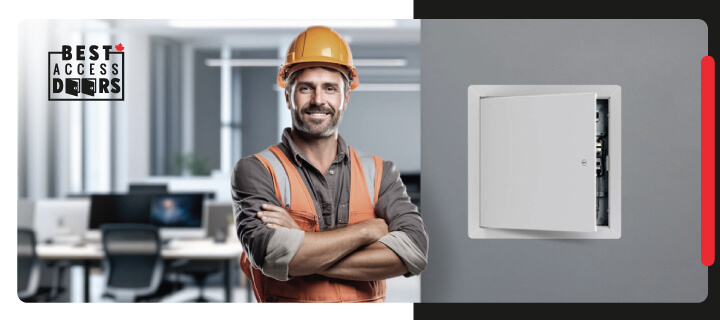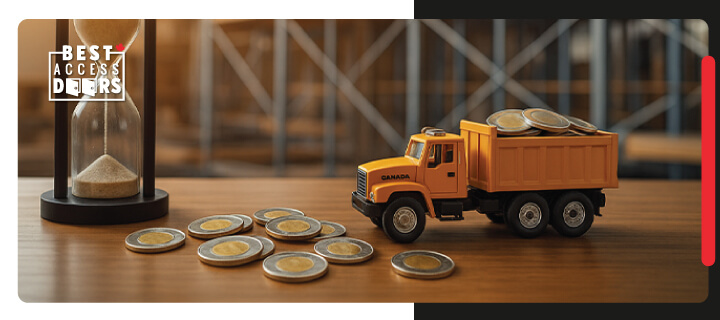Access Door Requirements: A Checklist Posted by Best Access Doors Canada on 9th Nov 2020
With access doors now becoming commonplace in both new and retrofit construction, we tend to overlook these requirements easily. Doors are frequently-used equipment that many people take for granted. When designing a new building or replacing a door, you need to consider the purpose and the requirements before selecting. The following guidelines can be useful in creating operational success for your access doors.
__ Determine the Purpose
The first thing you should ask yourself is – what is the purpose of this door? Perhaps this door allows your customers to access your building, or maybe it is a bay door that opens to allow trucks to deliver a product. Or maybe it is a front door that leads to a residential dwelling. Choosing the type of door for your project will depend on its function. For instance, creating a storefront needs a user-friendly door that still meets safety standards. The addition of windows or installation of glass doors can also be the right solution to allow customers to look inside the store and gain their interest in its products. No matter what type of building it is, knowing the door's purpose will guide you in your search of the most optimal access door.
__ Identify the Safety Requirements
When considering access doors, another aspect that you should consider is safety requirements. Since many access doors are entry and exit points for rooms or important building areas, different safety requirements are necessary for additional access points. One example is a door for workshops. Such a door should be fire-rated, as per the building code. It means that they must be self-closing and be able to withstand the heat of a burning fire. You could incorporate other requirements that are shatter-proof glass or doors with windows to allow for sightlines on the other side. Moreover, building codes and individual businesses also need to comply with safety requirements. It is why checking local building codes and ensuring the door meets the business's safety needs is essential before installing a new door.
__ Choose the Aesthetics
Take note that doors provide entry to a business place or home. While the door's function is paramount, it is also essential to put a lot of thought into aesthetic appeal. Keeping with the building's design itself is extremely important, whether you are looking to retrofit a door onto an existing building or match a new entry to a modern building. A door that does not suit the overall structure will stand out in the wrong way. You should also consider the building color when choosing the door, including the material that composes it and its size. Take, for instance, large doors that match large buildings. Imagine a skyscraper with a tiny door. Wouldn't it look odd? Thus, the scale of the building is critical in determining the door. Likewise, it is the same when a large glass door goes on an old wooden building-- it just does not look right. While the viewers cannot pinpoint what is wrong with the design, their brains can identify that something is not correct. The aesthetic appeal always matters, and the same holds if you have a run-down or odd-looking building. People will associate building peculiarities with the business; that's why the company's structure can be part of the marketing. So, do yourself a huge building and select a door that is ideal for your building style.
__ Select Materials
Similar to other door elements, another significant matter is the material that composes the door. Numerous factors go into choosing the perfect door material. As previously mentioned, the building design itself is also a factor. For example, a timber-sided building will work best with a wooden door, a contemporary building with a steel door, and a window-filled building with a glass door. The list goes on when considering the building design.
Furthermore, the safety requirements of the door should also play a role in choosing the material. For instance, doors that maintain sightlines need to be made of glass, while entries for factories need to be fire-rated. The material will dictate the door installation to choose and its functions.
__ Consider the Climate
Depending on where the building is, your access door will need to withstand different pressures. For example, a building in British Columbia will need the door to put up with constant rain. By comparison, Ottawa's city deals with frequent weather changes and a significant freeze/thaw cycle. Your access door will need to be able to deal with the expansion and contraction that comes with these cycles. When you are considering what climate your door needs to withstand, you should also consider the environment inside your building. Is the door for a restaurant, where there will be constant heat from the kitchen?
Or a plant nursery, where the temperature is relatively high, and the air is humid. Or maybe your building is a cold storage warehouse that contains a large refrigeration unit. Climate, both indoors and outdoors, matter when selecting your door.






